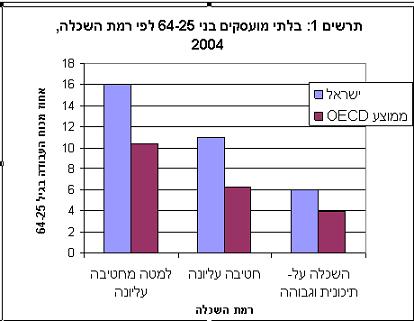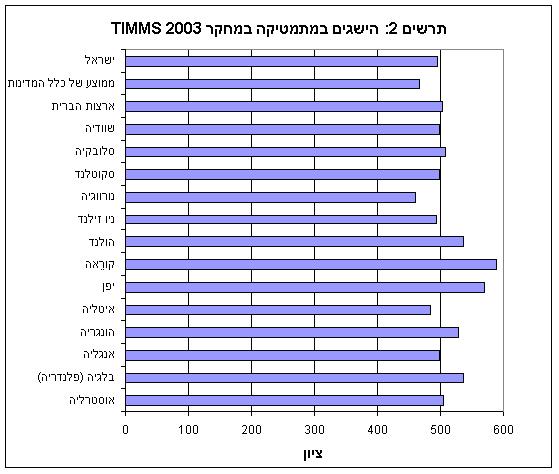This is according to the survey "Education in Israel - an international comparison" published yesterday by the Central Bureau of Statistics * The publication also shows that a person who has not completed elementary school has a 2.5 times greater chance of being unemployed than a person with a secondary and higher education *

Recently, the CBS published the publication "Education in Israel - International Comparison 2004". The purpose of this publication is to present a snapshot of education in Israel on its various aspects. For this purpose, indicators of the education system in Israel appear in the publication, comparing them with those of the member countries of the OECD organization.
The data were taken from the organization's "Education at a Glance - OECD Indicators 2006" publication, and from its website, and refer to the year 2004. Also, there are findings from the TIMSS 2003 tests that examine the degree of success of XNUMXth and XNUMXth grade students in science and mathematics. (Trends in International Mathematics and Science Study)
education and employment
Among the 64-25 year olds in Israel, the percentage of those with at least a high school education (79%) is higher than the average in the OECD countries (67%). The rate of high school graduates from the typical age group is: in Israel 93% compared to 81% on average in the OECD countries. In Israel, as in most OECD countries, more girls than boys graduate from the academic track, while more boys than girls graduate from the professional-technological track.
Israel is among the countries where the percentage of those with higher education is one of the highest (29% among the 25-64 year olds), and among the OECD countries it is lower only than the United States. The proportion of women in Israel who received an academic degree in 2004 (50%), is higher than the average in the OECD countries (42%). The rate is high in Israel in all fields of study except engineering.
The rate of the unemployed in the labor force aged 64-25 in Israel is higher than the average in OECD countries at all levels of education. - 16% among those with an education of less than an upper division in Israel compared to 10.4% in the average of the OECD countries, 11% among those with an upper division education and pre-academic studies compared to 6.2% in the average of the countries, and 6% among those with post-secondary and higher education compared to 3.9% in the average of the countries (see diagram 1).
learning lessons
The rate of students among the 5-14 year olds in Israel is similar to the average in the OECD countries; At the ages of 15-17, the rate of students in the education system in Israel is higher than the average in the OECD countries, but falls at the ages of 18-20 (something that can be attributed to the military service obligation in Israel).
The majority of students in post-secondary and higher education in Israel study in budgeted private institutions, while in the OECD countries most of those studying in higher education study in public institutions (76.7%) - with the exception of Belgium, Japan, Korea, the Netherlands and the United Kingdom.

Overcrowding in classrooms and teaching staff
In elementary education in Israel, there are about 27 students in a class on average compared to 22 in the OECD countries. Middle schools in Israel have an average of 32 students per class. Among the OECD countries, only Japan and Korea have higher classroom density.
The starting salary of the teaching staff in primary and secondary education in Israel in purchasing power parity terms is about half of the average in the OECD countries. After 15 years of experience the gap has even increased.
The ratio between teachers' salary after 15 years of experience to GDP per capita is low in Israel (0.73) compared to this ratio in the average country
The OECD (1.42). It should be noted that in countries such as Hungary, Poland, Turkey, Chile and Israel, both GDP per capita and teachers' salaries are relatively low compared to other OECD countries; This is in contrast to countries such as Korea, Portugal and Spain, where the GDP per capita is low but teachers' salaries are equivalent to countries where the GDP per capita is higher.
In the OECD countries, primary school teachers teach 805 hours per year on average. Israel (where 1,025 hours are taught) is second only to the United States (where the number of hours is 1,080) in the number of hours of instruction at this level of education. In the middle school, the average number of teaching hours in Israel is 788 hours per year, while in the OECD countries it is 704. The teaching time spent in the upper division in Israel (665 hours) is similar to the average in the OECD countries (663 hours).
The teachers in Israel are younger than in the OECD countries on average, something that stands out especially in elementary education: in the OECD countries on average about 28.4% of the teachers are over the age of 50, and in Israel - only about 17.5%.
Grades in math and science (TIMSS study)

In 2003, the average grade in mathematics of students in Israel was 496 (compared to 467 - the international average), similar to that in Sweden (499), Scotland (498) and New Zealand (494) (see Chart 2). The achievements of students in Israel in science (488, compared to 474 - the international average in science), are similar to those of students in Norway (494), Italy (491) and Bulgaria (479). Israel is among the countries where scores improved between 1999 and 2003, both in mathematics (by 29 points, see Figure 3) and in science (by 20 points). This improvement is greater than that of any OECD country that participated in the exams, and the majority of all the countries that participated in them. However, even after this improvement, the achievements of Israeli students are lower than those of students in most of the participating OECD countries. The average score in Israel is similar to that in Sweden.
Comparing the achievements between the sexes shows that in most countries the achievements of boys are higher than the achievements of girls in mathematics and science. On the international average, the advantage of boys in science is on average 6 points, and in Israel - 20 points. In mathematics, boys have an advantage of one point in the international average, and in Israel - 8 points.
25% of 31th grade students in Israel and 10% of 50th grade students in the countries that participated in the study study in schools where the economic status of most of the students is low. In schools where up to 2003% of the students have a poor economic situation, the scores are higher than in schools where more than XNUMX% of the students are in this economic situation; This is in all the OECD countries and in most of the countries that participated in TIMSS XNUMX as well as in Israel.
In Israel, the proportion of students whose school attendance is low decreased to 2003% in 16, compared to 36% in 1999. The proportion of students in Israel with high attendance discipline was 13% in 2003, compared to 7% in 1999, and lower than the international average (23% ).
